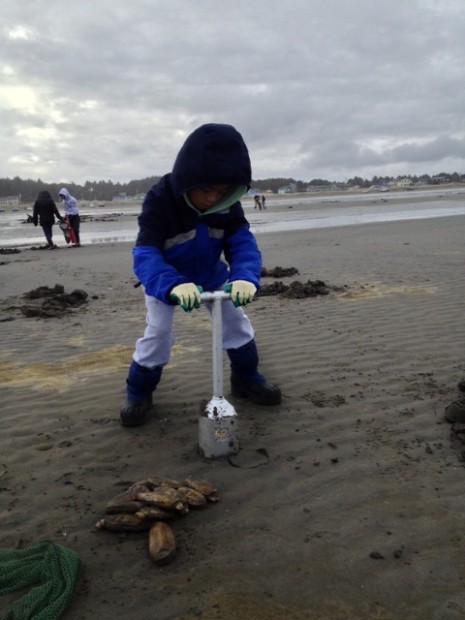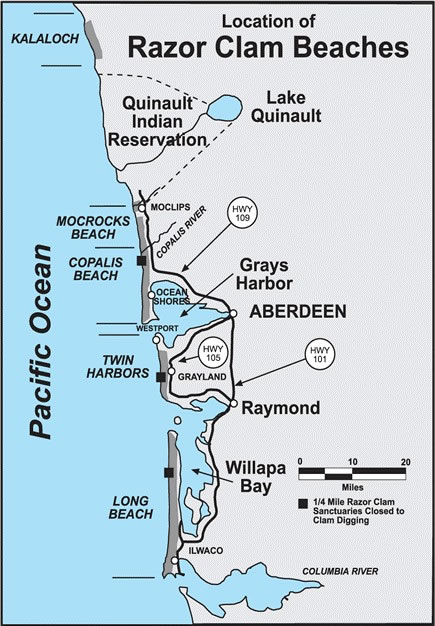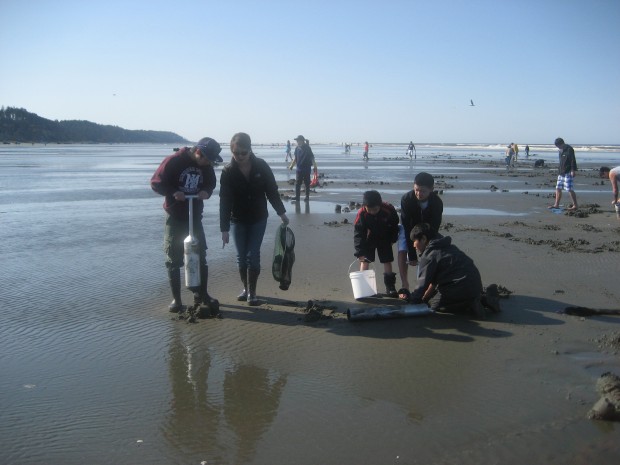Dig this! First coastal razor clam digs approved to begin this Friday and the outlook should be excellent Leave a reply

By Mark Yuasa
It’s almost time to dig into what should be a grand coastal razor clam season!
The Washington Department of Fish and Wildlife (WDFW) gave final approval for the initial series of digs from Friday (Sept. 17) through Saturday (Sept. 25) at Long Beach, Twin Harbors, Copalis and Mocrocks beaches only.
The first digs will occur during morning low tides on Sept. 17-22, and then switch to evening low tides on Sept. 23-25. The best period to head out are one to two hours before low tide change.
Here are the upcoming morning low tides – Sept. 17, -0.4 feet at 4:30 a.m. at Long Beach, Twin Harbors, Mocrocks; Sept. 18, -0.5 at 5:22 a.m. at Long Beach, Twin Harbors, Copalis; Sept. 19, -0.6 at 6:06 a.m. at Long Beach, Twin Harbors, Mocrocks; Sept. 20, -0.5 at 6:45 a.m. at Long Beach, Twin Harbors, Copalis; Sept. 21, -0.2 at 7:21 a.m. at Long Beach, Twin Harbors, Mocrocks; and Sept. 22, 0.3 at 7:54 a.m. at Long Beach, Twin Harbors, Copalis.
Evening low tides – Sept. 23, 0.3 at 8:58 p.m. at Long Beach, Twin Harbors, Mocrocks; Sept. 24, 0.4 at 9:36 p.m. at Long Beach, Twin Harbors, Copalis; and Sept. 25, 0.5 at 10:15 p.m. at Long Beach, Twin Harbors, Mocrocks.
WDFW will do further testing for marine toxins and announce additional tentative digs about a week before each series.
They will occur on Oct. 3 and 5 at Long Beach, Twin Harbors and Copalis during morning low tides; and Oct. 4 at Long Beach, Twin Harbors and Mocrocks.

It’ll then switch to evening low tides on Oct. 6, 8, 10, 20, 22 and 24; Nov. 3, 5, 7, 9, 17, 19, 21 and 23; and Dec. 2, 4, 6, 8, 15, 17, 19, 21, 23 and 30 at Long Beach, Twin Harbors and Mocrocks; and Oct. 7, 9, 11, 19, 21, 23 and 23; Nov. 4, 6, 8, 10, 16, 18, 20, 22 and 24; and Dec. 1, 3, 5, 7, 9, 16, 18, 20, 22 and 31 at Long Beach, Twin Harbors and Copalis.
The reason behind this liberal 67 days of digging being offered through Dec. 31 is an estimated 56.3-million harvestable clams on four beaches.
Long Beach has 21.6-million recruit-size razor clams and an 8.6-million total allowable catch (TAC) for the 2021-2022 season.
At Twin Harbors, assessments showed 8.5-million recruit-size clams with a 3.4-million TAC.
At Copalis, the recruit-size clam total is 16.5-million with a recreational TAC of 3.3-million. Mocrocks has 9.8-milllion recruit-size clams and a recreational TAC of 2.3-million. Kalaloch will remain closed this season.

To reinforce the high abundance on the four beaches, WDFW boosted the daily limit from 15 to 20 razor clams from Sept. 17 through Dec. 31.
According to Ayres, a bonus limit occurred just once in his 41-year career with WDFW, when Long Beach had a 25-clam limit during a brief six-days in the 2016-2017 spring season.
Prior to that you’d have to go way back to 1929 when it was 36 clams before a reduction to 24 clams in 1948, and eventually the long-standing 15 clam limit in 1974.
Marine toxins dealt a blow to the 2020-2021 season when domoic acid – a natural toxin generated by certain marine algae types, which can be harmful or even fatal if consumed in high enough quantities – wiped out a substantial amount of digging opportunities.
The most recent testing show toxins are declining, and well under the action cutoff level. Whatever’s left in clams right now is residual from last spring, and it takes time to flush it out of their system.
Each digging series requires two consecutive test samples (taken weekly) to fall under the action threshold. Final approval is usually announced one to two weeks prior to each series.
Once the first-half of the season is completed, WDFW will likely add more dates for late-winter and spring digging opportunities. For more on razor clams, go to http://wdfw.wa.gov/fishing/shellfish/razorclams/.

